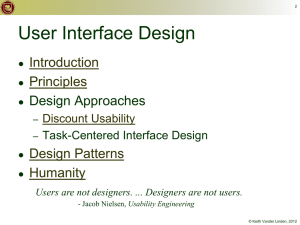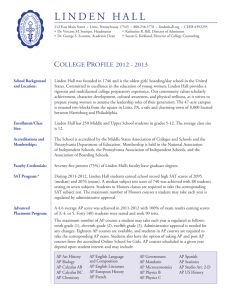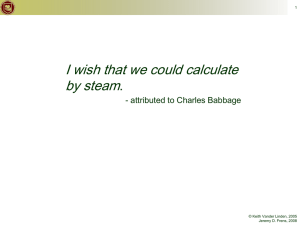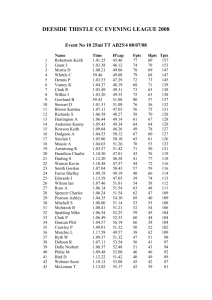03spreadsheets - Calvin College
advertisement
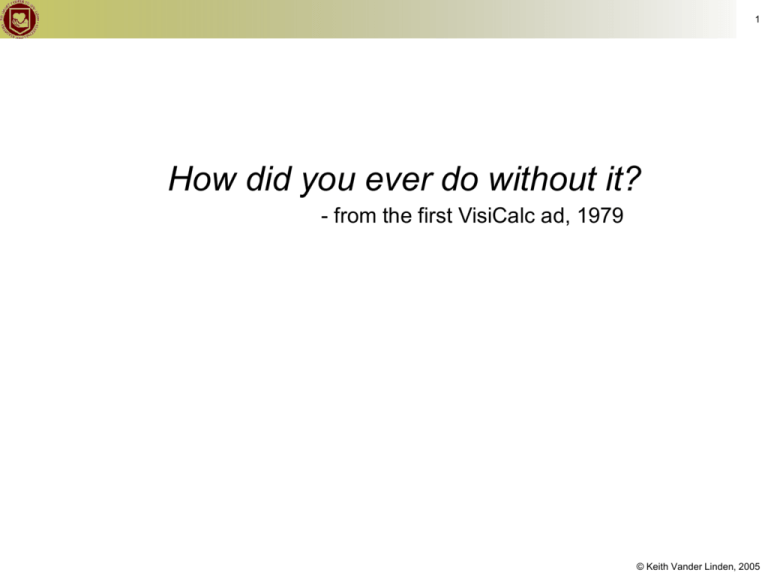
1 How did you ever do without it? - from the first VisiCalc ad, 1979 © Keith Vander Linden, 2005 2 Accountant’s Paper Ledger 2-Dimensional representation of accounting data image from Grauer&Barber, Excel 2003, Prentice Hall, Oct., 2004 © Keith Vander Linden, 2005 3 Dan Bricklin (1951-) VisiCalc ● ● ● ● 1979 Visible, interactive accountants ledger Developed for the Apple II A “killer” business application for the personal computer images from www.bricklin.com, Oct., 2004 © Keith Vander Linden, 2005 6 “What if?” ● ● The biggest advantage a spreadsheet has is the ability to ask the “what if?” questions (and get a quick answer). Be very, very lazy (in the long run): – Use equations to compute answers as much as possible. – “What if” questions answered by tweaking the data. © Keith Vander Linden, 2005 7 Spreadsheet Cells ● ● Worksheets are 2-dimensional arrays of cells. Each cell is referred to by its cell reference. – ● Examples: A1, E10, AZ1024 Cells can be grouped as a range. – Examples: A1:E10, C5:Q8 © Keith Vander Linden, 2005 8 Spreadsheet Values ● Constants/literals – A number – A text label ● Formulas (always begins with an =) – Numbers – Arithmetic (+, -, *, /) – Functions ● Worksheet contents are updated in real time. © Keith Vander Linden, 2005 9 Be Very, Very Lazy ● This usually means doing some work up front. Can easily ask “what if?” – Compute correct answers. – ● Guidelines – No numbers in formulas. – sum() and average() should refer to ranges. © Keith Vander Linden, 2005 10 Relative/Absolute Addressing ● When cells are copied: – relative addresses are modified automatically – absolute addresses always refer to the same cell ● Syntax: Relative address: A1 – Absolute address: $A$1 – ● Use the F4 key!! © Keith Vander Linden, 2005 13 Spreadsheet Issues ● Powerful tools can create powerful problems. © Keith Vander Linden, 2005 14 Technology and Humanity What’s the Big Idea ● Working with technology can be dehumanizing. ● “Be fruitful and increase in number; fill the earth and subdue it.” - Genesis 1:28 © Keith Vander Linden, 2005 15 Graphs and Charts ● Quantitative data can frequently be illustrated in a compelling way using charts and graphs. ● Spreadsheet systems usually provide graphing and charting capabilities. Here are some examples. ● © Keith Vander Linden, 2005 © Keith Vander Linden, 2005 © Keith Vander Linden, 2005 18 image from VDQI, 1983 © Keith Vander Linden, 2005 19 Chart Types Calvin Expenditures, 2003-2004 ● Pie charts Financial Other, $23.5 Aid, $20.8 Food, $6.0 Salaries, $35.3 Benefits, $15.6 2004 Election Voting Percentages - Michigan 60% Column/bar charts 40% Percentage ● 51% 48% 50% 30% 20% 10% 1% 0% 0% 0% 0% Nader Badnarik Cobb Peroutka Brown 0% Bush Kerry Candidate Line charts 4,400 4,300 4,200 4,100 4,000 3,900 3,800 3,700 Enrollment ● College Enrollments Year ● Maps © Keith Vander Linden, 2005 20 Graph/Chart Issues ● Data values can, however, be obscured or misrepresented using charts. ● Here are some examples. © Keith Vander Linden, 2005 © Keith Vander Linden, 2005 © Keith Vander Linden, 2005 23 image from VDQI, 1983 © Keith Vander Linden, 2005 25 image from VDQI, 1983 © Keith Vander Linden, 2005 26 Edward Tufte (1940-) VDQI, 1983 Lying graphics cheapen the graphical art everywhere … When a chart on television lies, it lies millions of times over; when a New York Times chart lies, it lies 900,000 times over to a great many important and influential readers. VDQI, p. 53-79 images from www.edwardtufte.com, Oct., 2004 © Keith Vander Linden, 2005 27 from Calvin College Chimes, Oct. 6, 2000 © Keith Vander Linden, 2005 28 from Calvin College Chimes, Sept. 29, 2000 © Keith Vander Linden, 2005 29 Wheaton 25% Calvin 20% Hope 25% Kalamazoo 30% image from Exploring Microsoft Excel 97, Grauer & Barber, 1998 © Keith Vander Linden, 2005 30 Amount MyCompany.com $45 $40 $35 $30 $25 $20 $15 $10 $5 $0 profit sales 2002 2003 2004 2005 Year image from Exploring Microsoft Excel 97, Grauer & Barber, 1998 © Keith Vander Linden, 2005 31 Using Charts/Graphs Properly ● ● Decide what you want to present. Present it accurately and unambiguously. – – – – – Let the graphic values/change accurately depict the data values/change. Clearly label all relevant details. Don’t graphically mix dissimilar elements. Use the right type of graph. Don’t add “chartjunk”. © Keith Vander Linden, 2005 32 Technology and Lying What’s the Big Idea ● It is as easy to lie or mislead with technology. ● “When he lies, he speaks his native language, for he is a liar and the father of lies.” - John 8:44 © Keith Vander Linden, 2005

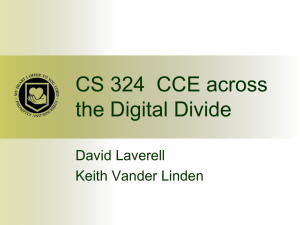
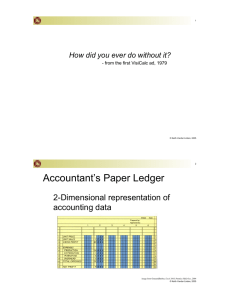
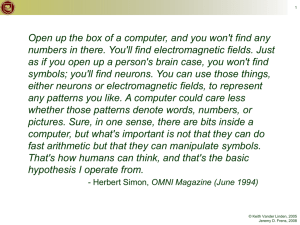
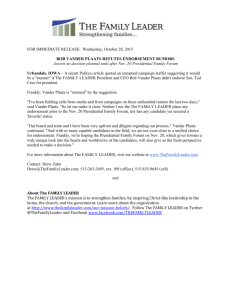
![[#SWF-809] Add support for on bind and on validate](http://s3.studylib.net/store/data/007337359_1-f9f0d6750e6a494ec2c19e8544db36bc-300x300.png)
